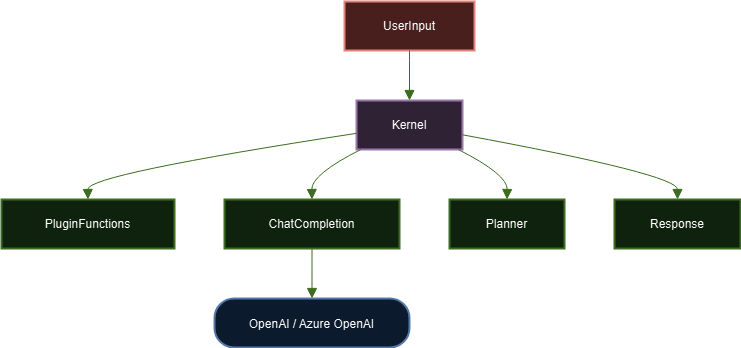🔍 What is Semantic Kernel?
Semantic Kernel is an open-source SDK developed by Microsoft that lets you infuse AI capabilities (like OpenAI, Azure OpenAI, HuggingFace) into your apps by:
✅ Integrating LLMs (e.g., GPT-4) ✅ Creating modular AI plugins (called functions) ✅ Enabling function calling, planners, memory, and agents ✅ Supporting multimodal workflows (text, embeddings, images)
🧹 Key Features
- Kernel: The brain that coordinates AI calls, plugins, memory, and more
- Plugins: Reusable functions exposed to the LLM
- Planners: Converts goals into multi-step plans using AI
- Memory: Store and recall past interactions (long-term memory)
- Agents: Autonomously act using LLMs, context, and function calls
- Connectors: Native integration with OpenAI, Azure OpenAI, HuggingFace, and more
🛠️ Supported Languages
- C# (.NET 8) – Most mature implementation
- Python
- Java – (Experimental)
⚙️ How It Works – Simplified Flow

- You send a prompt like “Send a thank-you email”
- The Kernel evaluates context and finds matching plugin functions
- It uses the LLM to execute or plan steps
- The response is returned with reasoning and actions
🚀 Best Use Cases for Semantic Kernel
1. 🚣️ Conversational AI Agents
Create chatbots, support agents, or assistants that:
- Call plugins (e.g., check weather, send emails)
- Maintain memory
- Autonomously plan steps
- Route between plugins and LLM
🧠 Example: A personal assistant that manages your calendar, files, and emails through voice/text.
2. 📄 Automated Document Processing
Use Semantic Kernel for:
- Summarizing reports
- Extracting data (names, dates, entities)
- Structuring unstructured PDFs/emails
🧠 Example: A tool that processes resumes and classifies them by skills.
3. ✨ AI Copilots for Internal Tools
Embed AI in:
- CRM
- ERP dashboards
- Code documentation systems
SK plugins can wrap your APIs or business logic, and allow the LLM to smartly route queries.
🧠 Example: “What were our top 3 deals last quarter?” → Plugin calls CRM API → returns answer.
4. 🧠 Knowledge Retrieval Systems (RAG)
Use embeddings + vector databases to:
- Search across documents or knowledge bases
- Add long-term memory
- Retrieve relevant info before LLM answers
🧠 Example: Ask questions to a 10,000-page PDF repository in natural language.
5. 🤖 Autonomous Multi-Agent Systems
Coordinate agents that:
- Have their own memory and personality
- Collaborate through messages
- Solve tasks in parallel
🧠 Example: A research agent, writer agent, and SEO agent that together generate and publish a blog post.
🧠 Why Choose Semantic Kernel?
| Feature | Semantic Kernel | LangChain | LlamaIndex |
|---|---|---|---|
| .NET Support | ✅ Best-in-class | ❌ | ❌ |
| Function Calling | ✅ Plugins via attributes | ✅ | ❌ |
| Native Planner | ✅ Handlebars Planner | ⚠️ | ⚠️ |
| Agentic Framework | ✅ Built-in | ⚠️ Basic | ⚠️ Experimental |
| Open Source | ✅ MIT License | ✅ | ✅ |
📦 Sample Plugin Code (C#)
|
|
The LLM can automatically invoke this when you say: “What’s 5 plus 7?”
📘 Conclusion
Microsoft Semantic Kernel is not just a wrapper around LLMs. It’s a composable framework for building intelligent, context-aware, and action-driven applications.
Whether you’re automating internal tools, building agents, or enabling AI-first product experiences—SK gives you the modularity and power needed.
